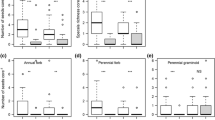Summary
Effects of pocket gopher (Geomys attwateri) mound-building activity on plant community composition and soil nutrient concentrations were investigated in south Texas on both burned and unburned coastal prairie sites. Pocket gophers deposited large amounts of soil which were lower in nutrient content than randomly-collected samples. Above-ground plant biomass was greater around mounds than in random samples mainly because of increased dicots around mounds on the burned area when compared with random samples on the same area. Pocket gophers may have concentrated their activities (and therefore, mounds) in areas with higher dicot biomass on the burned area since they prefer perennial dicots as food, or the presence of mounds may have ameliorated the apparent negative effect of fire on dicots.
Similar content being viewed by others
References
Baker RJ, Williams SL (1972) A live trap for pocket gophers. J Wildl Manage 36:1320–1322
Belovsky GE (1978) Diet optimization in a generalist herbivore: the moose. Theor Pop Biol 14:105–134
Buechner HK (1942) Interrelationships between the pocket gopher and land use. J Mammal 23:346–348
Downhower JF, Hall ER (1966) The pocket gopher in Kansas. Kans Mus Nat Hist Misc Pub 44:1–32
Drawe DL, Chamrad AD, Box TW (1978) Plant communities of the Welder Wildlife Refuge. Contribution No. 5, Series B, Revised, Welder Wildlife Refuge, Sinton, Texas
Ellison L (1946) The pocket gopher in relation to soil erosion on mountain range. Ecology 27:101–114
Foster MA, Stubbendieck J (1980) Effects of the plains pocket gopher (Geomys bursarius) on rangeland. J Range Manage 33:74–78
Glander KE (1981) Feeding patterns in mantled howler monkeys. In: Kamil AC, Sargent TD (eds) Foraging behavior: ecological, ethological, and psychological approaches. Garland STPM Press, New York, pp 231–257
Grant WE, McBrayer JF (1981) Effects of mound formation by pocket gophers (Geomys bursarius) on old-field ecosystems. Pedobiologia 22:21–28
Grant WE, French NR, Folse LJ (1980) Effects of pocket gopher mounds on plant production in shortgrass prairie ecosystems. Southwest Nat 25:215–224
Guckian WJ, Garcia RN (1979) Soil survey of San Patricio and Aransas Counties, Texas. USDA Soil Conservation Service
Hansmire JA (1983) Effect of fire on forbs and grasses in the Texas coastal prairie. Masters thesis, Texas Tech University, Lubbock
Laycock W (1958) The initial pattern of revegetation of pocket gopher mounds. Ecology 39:346–351
Laycock WA, Richardson BZ (1975) Long-term effects of pocket gopher control on vegetation and soils of a subalpine grassland. J Range Manage 28:458–462
McDonough WT (1974) revegetation of gopher mounds on aspen range in Utah. Great Basin Nat 34:267–274
Miller MA (1957) Burrows of the Sacramento Valley pocket gopher in flood-irrigated alfalfa fields. Hilgardia 26:431–452
Milton K (1979) Factors influencing leaf choice by howler monkeys: a test of some hypotheses of food selection by a generalist herbivore. Amer Nat 114:362–378
Moore AW, Reid EH (1951) The Dalles pocket gopher and its influence on forage production of Oregon mountain meadows. US Dep Agr Circ 884:1–36
Nie NH, Hull CH, Jenkins JG, Steinbrenner K, Bent DH (1975) SPSS, Statistical package for the social sciences. Second edition. McGraw-Hill Book Co, New York
Reichman OJ, Whitham TG, Ruffner GA (1982) Adaptive geometry of burrow spacing in two pocket gopher populations. Ecology 63:687–695
Richens VB (1966) Notes on the digging activity of a northern pocket gopher. J Mammal 47:531–533
Siegel S (1956) Non-parametric statistics for the behavioral sciences. McGraw-Hill, New York
Sokal RR, Rohlf FJ (1981) Biometry. WH Freeman and Co, San Francisco
Tilman D (1983) Plant succession and gopher disturbance along an experimental gradient. Oecologia (Berlin) 60:285–292
Turner GT, Hansen RM, Reid VH, Tietjen HP, Ward AL (1973) Pocket gophers and Colorado mountain rangeland. Colorado State Univ Agr Exp Sta Bull 554S
Vleck D (1981) Burrow structure and foraging costs in the fossorial rodent, Thomomys bottae. Oecologia (Berlin) 49:391–396
Williams LR, Cameron GN (1984) Effects of removal of pocket gophers on a Texas coastal prairie. (Submitted)
Author information
Authors and Affiliations
Rights and permissions
About this article
Cite this article
Spencer, S.R., Cameron, G.N., Eshelman, B.D. et al. Influence of pocket gopher mounds on a Texas coastal prairie. Oecologia 66, 111–115 (1985). https://doi.org/10.1007/BF00378561
Received:
Issue Date:
DOI: https://doi.org/10.1007/BF00378561




